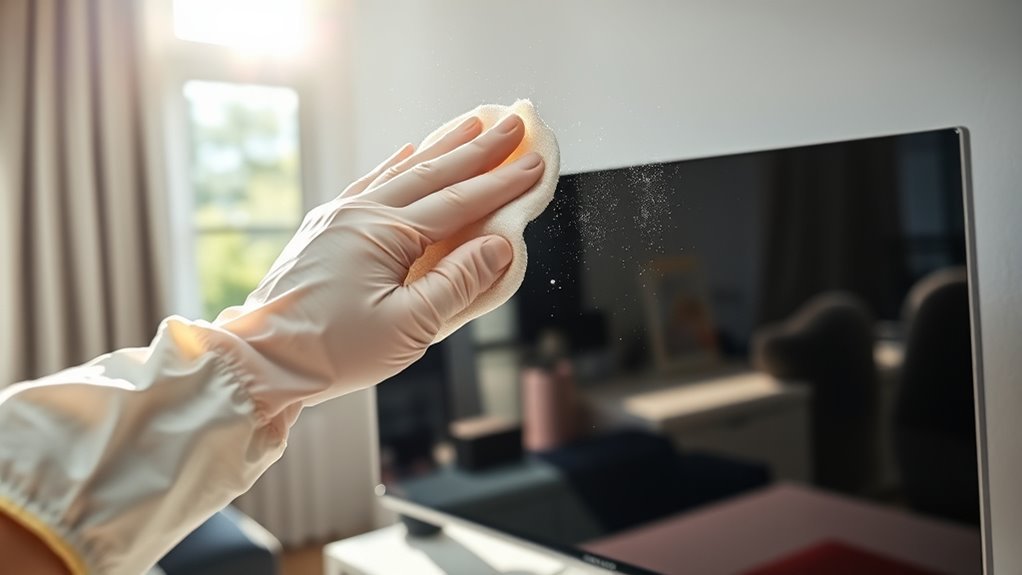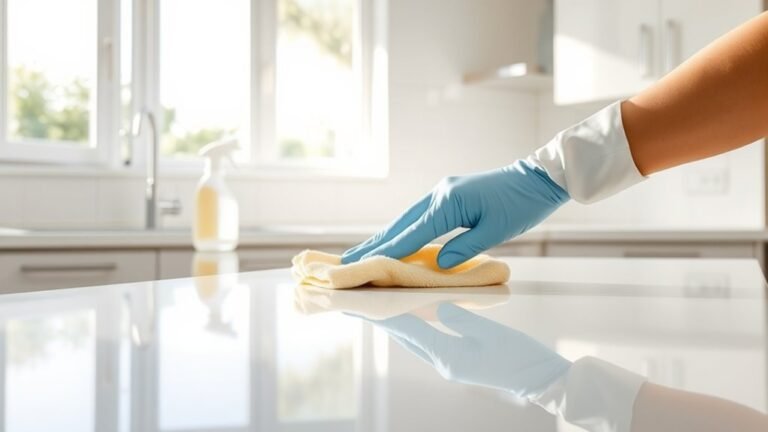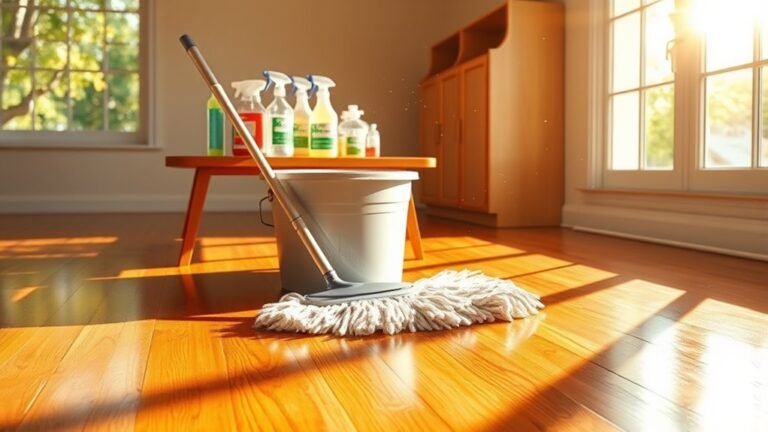Spring Cleaning Guide for Dust
To tackle dust this spring, start by understanding its sources like skin cells, pollen, and pet dander. Use microfiber cloths and natural cleaners to safely dust wood, electronics, and upholstery without damage. Don’t forget hard-to-reach spots and regularly clean or replace air filters to reduce buildup. Create a dusting schedule and take preventative steps like closing windows on windy days to keep dust at bay longer. Keep going to uncover more smart strategies for lasting freshness.
Understanding the Sources of Dust in Your Home

Although dust might seem like just a nuisance, understanding where it comes from is key to keeping your home cleaner. You’ll find that dust sources are more varied than you might expect. Dust particles come from dead skin cells, fabric fibers, pet dander, and even outdoor dirt tracked inside. Airborne particles from pollen and pollution also sneak in through windows and vents. Knowing these origins gives you the freedom to target your cleaning efforts effectively. By recognizing where dust settles and how it accumulates, you can take control of your environment. This awareness helps you maintain a fresher, less cluttered space without feeling trapped by constant dusting. Embrace this knowledge, and you’ll feel more empowered to keep your home truly dust-free.
Essential Tools for Effective Dusting
Now that you know where dust comes from and how it builds up, the next step is to equip yourself with the right tools to tackle it efficiently. Start with microfiber cloths—they’re lightweight, reusable, and trap dust instead of just pushing it around. These cloths give you the freedom to clean thoroughly without harsh chemicals. Pair them with dusting sprays designed to capture dust particles and leave surfaces fresh. These sprays help loosen stubborn dust, making your job easier and quicker. Avoid using feather dusters, as they often scatter dust back into the air. By choosing microfiber cloths and dusting sprays, you’re setting yourself up for a cleaner, freer space where dust won’t hold you back. These tools make dusting less of a chore and more of a breeze.
Best Techniques for Dusting Different Surfaces

When dusting wood surfaces, you’ll want to use a soft cloth to avoid scratches and maintain the finish. For glass and mirrors, a lint-free cloth with a gentle cleaner works best to prevent streaks. Upholstery and fabrics need a vacuum or a fabric brush to lift dust without damaging the material.
Wood Surface Dusting
Since wood surfaces can be sensitive to harsh cleaning methods, you’ll want to choose dusting techniques that protect their finish while effectively removing dust. Start by using a soft, microfiber cloth or a feather duster to gently lift dust without scratching. Avoid wet cloths or harsh chemicals that can damage the wood’s natural oils and finish. For deeper cleaning, use a wood care product designed specifically for dust prevention that nourishes and creates a barrier against future buildup. Regular dusting is key to maintaining the wood’s beauty and extending its life, giving you the freedom to enjoy your space without worrying about damage. With the right approach, you can keep your wood surfaces clean, vibrant, and dust-free effortlessly.
Glass and Mirrors
Although glass and mirrors might seem easy to clean, they require careful dusting to avoid streaks and scratches. You want to embrace mirror maintenance and glass polishing techniques that keep surfaces clear and shining without damage. Use a microfiber cloth dampened with a gentle cleaner, wiping in circular motions to lift dust and prevent streaks.
| Surface Type | Best Tool |
|---|---|
| Mirrors | Microfiber cloth |
| Window Glass | Squeegee |
| Glass Tables | Soft lint-free cloth |
| Picture Frames | Soft brush |
Upholstery and Fabrics
Upholstery and fabrics need special care to keep dust and allergens at bay without damaging delicate fibers. When you focus on upholstery care and fabric maintenance, you protect your furniture while breathing easier. Here’s how to tackle it effectively:
- Vacuum regularly using an upholstery attachment to lift dust without harming the fabric.
- Spot-clean stains promptly with gentle, fabric-safe solutions to prevent buildup.
- Use a lint roller or a soft brush to remove surface dust and pet hair.
- Rotate cushions and pillows to avoid uneven wear and dust accumulation.
How to Dust Electronics Without Causing Damage

When you’re dusting your electronics, you need to be extra careful to avoid causing damage. Start by unplugging devices to guarantee your safety and prevent electrical issues. Use a soft, microfiber cloth for safe cleaning—it traps dust without scratching surfaces. Avoid spraying cleaners directly on screens or electronics; instead, lightly dampen the cloth with a mixture of water and a small amount of isopropyl alcohol if necessary. Don’t use paper towels or abrasive materials that can harm delicate components. Gently wipe vents, keyboards, and screens to remove dust buildup, promoting better electronic care and longevity. Taking these simple steps lets you maintain your gadgets without risking harm, giving you the freedom to enjoy them longer and cleaner without worry.
Tips for Dusting Hard-to-Reach Areas
Cleaning your electronics carefully is just one part of dusting your space effectively. When tackling hard-to-reach areas like those with a high ceiling or ceiling fans, you’ll need some smart strategies. Here’s how to keep every corner dust-free without hassle:
- Use an extendable duster to reach ceiling fans and high ceiling corners safely.
- Employ microfiber cloths attached to long poles for precise dust removal.
- Consider a lightweight step ladder for stable access to tricky spots.
- Turn on your fan at low speed first to loosen dust, then clean to avoid spreading it around.
With these tips, you’re free to dust thoroughly without straining yourself or missing those hidden spots that usually gather dust.
Using Natural Products to Reduce Dust Accumulation
Since dust tends to settle quickly, using natural products can help reduce its buildup while keeping your home safe and fresh. You don’t have to rely on harsh chemicals to maintain a dust-free space. Natural cleaners like vinegar, baking soda, and essential oils offer effective, eco friendly options that protect both your health and the environment. For instance, mixing vinegar with water creates a powerful spray that traps dust without leaving residues. You can also use microfiber cloths dampened with these natural solutions to capture dust rather than just spreading it around. Embracing these eco friendly options gives you the freedom to clean confidently, knowing you’re minimizing toxins and promoting a healthier living space for you and your loved ones.
Cleaning and Maintaining Air Filters to Minimize Dust
Anyone looking to reduce dust should pay close attention to their air filters. These filters play an essential role in trapping dust particles and improving your indoor air quality. To keep your space feeling fresh and free, focus on these key steps:
- Identify the filter types your system uses, whether HEPA, fiberglass, or pleated.
- Check filters monthly for dust buildup and damage.
- Follow manufacturer guidelines for filter replacement to maintain efficiency.
- Clean reusable filters with water and mild detergent, then let them dry completely before reinstalling.
How to Dust Upholstery and Fabric Items
Three simple tools can make dusting upholstery and fabric items much easier: a vacuum with an upholstery attachment, a soft brush, and a lint roller. Start with the vacuum to remove loose dust and debris without damaging the fabric. Next, gently brush the upholstery to loosen stubborn dust trapped in fibers, maintaining your fabric care routine. Finally, use a lint roller to pick up any remaining dust, pet hair, or lint. This method keeps your upholstery fresh and extends its life. Consistent upholstery cleaning not only brightens your space but also helps you breathe easier. By mastering these simple steps, you gain freedom from dust buildup and enjoy a cleaner, more comfortable home environment effortlessly.
Creating a Regular Dusting Schedule for Lasting Cleanliness
Although dusting might seem like a small task, creating a regular schedule guarantees your home stays consistently clean and allergen-free. Establishing a dusting frequency helps you avoid buildup and keeps your space feeling fresh without feeling tied down. Start by crafting a dusting checklist tailored to your home’s needs. Here’s how you can keep it simple and effective:
- Identify high-traffic and high-dust areas to prioritize
- Assign specific days for dusting different rooms or surfaces
- Keep your dusting checklist visible to track progress
- Adjust frequency monthly based on season and dust accumulation
Preventative Measures to Keep Dust at Bay Longer
Keeping up with a dusting schedule helps, but taking steps to prevent dust buildup can save you even more time and effort. You can embrace simple preventative habits like regularly changing air filters and keeping windows closed during windy days to reduce dust entry. Choosing dust resistant materials for your furniture and decor, such as leather or metal, also cuts down on how much dust settles. Using washable slipcovers and curtains lets you clean easily without hassle. Decluttering your space minimizes surfaces where dust can gather, giving you more freedom to relax without constant cleaning. By integrating these practical measures, you’ll not only enjoy a cleaner home longer but also reclaim your time and energy for what truly matters.
Häufig gestellte Fragen
Can Dust Cause Allergies or Respiratory Problems?
Yes, dust can definitely cause allergies and respiratory health risks. If you’re sensitive, you might notice dust allergy symptoms like sneezing, itchy eyes, or a runny nose. Breathing in dust over time can also irritate your lungs, making it harder to breathe freely. To protect yourself and enjoy your freedom, it’s important to keep your space clean and minimize dust buildup, helping you breathe easier and feel better overall.
How Often Should I Replace My Dusting Tools?
You should replace your dusting tools every 3 to 6 months, depending on dusting frequency and the condition of your cleaning materials. If you dust often, your tools wear out faster and trap dirt, reducing effectiveness. Don’t let old tools hold you back—fresh ones make cleaning quicker and easier, giving you more freedom to enjoy your space without the hassle of stubborn dust lingering.
Is It Better to Dust Before or After Vacuuming?
You’ll want to dust before vacuuming to make the most of your cleaning routine. Dusting techniques that loosen and gather dust particles first let the vacuum pick up what falls to the floor. If you vacuum before dusting, you risk missing settled dust that’ll just settle back down. So, stick to this vacuuming order for a freer, cleaner space without redoing your work or wasting effort—your home will thank you!
Do Air Purifiers Help Reduce Household Dust?
Isn’t it ironic how air purifiers quietly hum in the corner while dust still settles on your shelves? You’ll find that air purifier effectiveness in household dust management varies, but they do capture airborne particles, reducing dust buildup over time. If you want more freedom from constant cleaning, pairing a purifier with regular dusting and vacuuming gives you the best chance to keep your space fresh and dust-free.
What Are Common Myths About Dusting Debunked?
You might think quick swipes with a dry cloth get rid of dust, but that’s a common misconception. Effective dusting techniques involve using damp or microfiber cloths to trap dust instead of just moving it around. Another myth is that dusting once a week’s enough; dust accumulates fast, so regular care’s key. Don’t fall for the idea that air fresheners eliminate dust—they mask odors but don’t clean. You deserve freedom from dust, so use smart methods!






